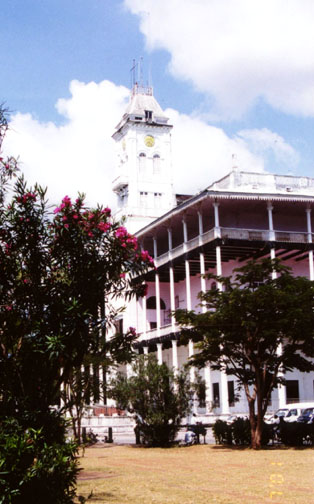

Stone Town
Zanzibar

Sultan's Palace
Zanzibar (city), city in eastern Tanzania, on the western coast of the island of Zanzibar. The capital of Zanzibar Urban/West Region, the town is a distribution center for the island's large clove crop, and the manufacture of clove oil is an important industry. The surrounding agricultural region also produces coconuts and citrus fruits. Zanzibar is the island's chief port and is served by both large and small vessels. It is also the hub for the island's road system and the location of an international airport.
the sea front
The town originated as early as the 8th century, as a port city for Indian Ocean trade. Settlement grew as Zanzibar's commercial importance increased, particularly after it became the primary residence of Omani sultan Said ibn Sultan in 1840.
street in Stone Town
Old Fort
built around 1700's on site of Portuguese chapel
by Omani Arabs
as seen from the Sultan's Palace
typical Stone Town building
building trim
showing Omani influenceFrom the 1840s Zanzibar attracted traders from the Indian Ocean, Europe, and North America.
Anglican Cathedral (1870's)
was the first Anglican cathedral in East Africa
(was constructed on the site of the former slave market)
Christ as an African
(stain glass window in the cathedral)
cross in cathedral commemorating Livingstone
grave marker for one of the Colonial masters
It became the primary slave market for the East African coast. Under British colonial rule after 1890, the town was the administrative capital for both Zanzibar and Pemba Island and a major center for the export of cloves.
Speaker on current Preservation efforts
cover for the newly installed sewer system
As an important international trading center it attracted a mixed population of Arabs, Swahili, South Asians, and Africans from the mainland.
Taarab Music
(a combination of African, Arab and Indian influences)
Musician
female singer
Following a revolution on the island of Zanzibar and its subsequent union with Tanganyika to form the nation of Tanzania in 1964, the town remained headquarters of the island's relatively autonomous administration. In the process most of the island's minority Arab and South Asian inhabitants were expelled. Population (1988) 157,634.
the restored Tembo hotel
More Photos from the Countryside